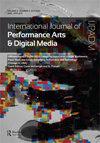执行电子人自我:身体攻击分布式自我的显性和隐性例子
IF 0.9
0 THEATER
International Journal of Performance Arts and Digital Media
Pub Date : 2021-05-04
DOI:10.1080/14794713.2021.1926748
引用次数: 0
摘要
今天,由于许多人完全在线工作和社交,我们比以往任何时候都更加敏锐地意识到身体(原位)与虚拟或数字扩展的自我之间的控制论关系。然而,即使在当前的全球大流行(COVID-19)爆发之前,当代的“身体”也必须通过全球通信系统被理解为超越了肉体。我们在这些平台上的实践如何揭示我们与分布式和数字化可变身体之间不断发展的关系?本文将我自己构建的电子人理论作为后人类话语的一个子集,将明确的电子人表演实践(如Stelarc和ORLAN)与日益平庸的身体黑客行为联系起来,因为它是在分布式社交媒体平台上(有意识和无意识地)自我表演中实现的。这些讨论既涉及当代自我表现的确定趋势,也涉及艺术家在这些空间中的作品作为对这些实践的评论、批评和应用。通过这一讨论,我展示了这些实践如何被理解为身体黑客,以及身体黑客如何既反映了与身体相关的个人赋权意识的增强,也反映了道德上模糊的范式身体的算法重新定义。本文章由计算机程序翻译,如有差异,请以英文原文为准。
Performing the cyborg self: explicit and implicit examples of body hacking the distributed self
ABSTRACT Today, as many work and socialize completely online, we are more acutely aware than ever of the cybernetic relationship between the body (in-situ) and the virtually or digitally extended self. However, even before the onset of the current global pandemic (COVID-19), the contemporary ‘body’ had to be understood as extended beyond physical flesh, through global communications systems. How do our practices on these platforms reveal our evolving relationships with a distributed and digitally mutable body? Drawing on my own construction of cyborg theory as a subset of posthuman discourse, this paper links the practices of explicitly cyborg performance, like Stelarc and ORLAN, with the increasingly banal practice of body-hacking as it is realized in the performance of the self (both consciously and unconsciously) on distributed, social media platforms. These discussions touch both on identified trends in contemporary self-representation as well as artists whose work within those spaces acts as a comment, critique, and application of those practices. Through this discussion, I show how these practices can be understood as body hacking and how that body hacking can both reflect an increasing sense of personal empowerment in relation to the body as well as a morally ambiguous algorithmic redefinition of the paradigmatic body.
求助全文
通过发布文献求助,成功后即可免费获取论文全文。
去求助
来源期刊

International Journal of Performance Arts and Digital Media
Arts and Humanities-Visual Arts and Performing Arts
CiteScore
1.70
自引率
0.00%
发文量
29
 求助内容:
求助内容: 应助结果提醒方式:
应助结果提醒方式:


